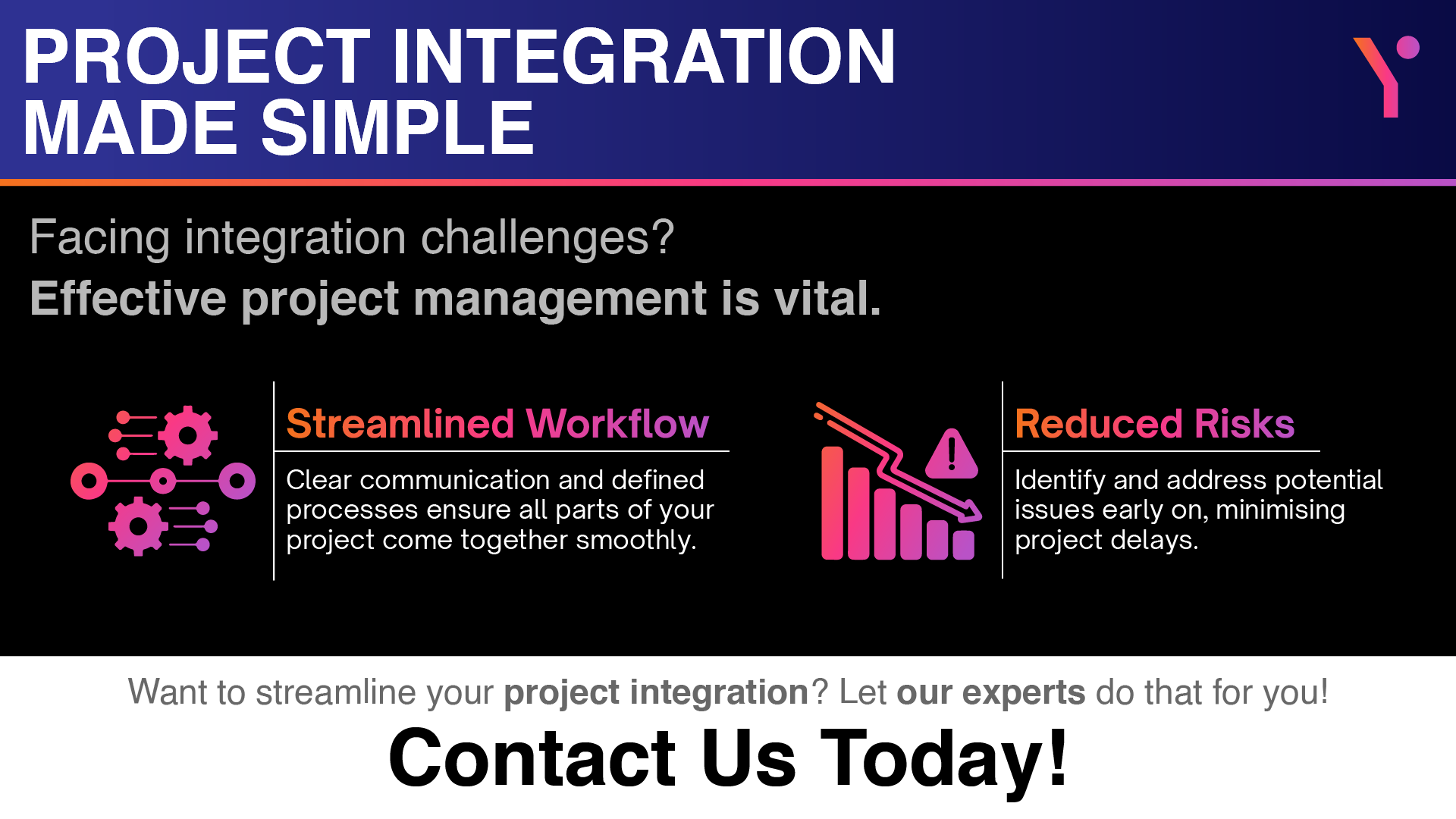Introduction
Are you going through project-related chaos? Well, Project Integration Management comes to your rescue. It can unite every project part, such as budgets and schedules. This ensures that I.T. and business work together. As a result, you can turn your ideas into reality, significantly increase project success chances and deliver real value.
We are truly living in interesting times. Across the dynamic business landscape, we see that successful projects rely heavily upon seamless collaboration between I.T. and business teams. It is also true that project integration management (PIM) is the foundation for attaining this alignment.
Note that project integration alignment comes as a systematic approach that brings unity to a host of project processes. This ultimately ensures that the processes work together in a harmonious manner. The result is the fostering of an adherent environment where I.T. solutions and business objectives blend and offer immense strategic value.
Need further guidance regarding project integration alignment? Contact FuturByte. We are a reputed ERP software development services provider that will be of immense aid to you.
Get to Know Project Integration Management
It is imperative to state that Project Integration Management behaves as the driver of the entire project. This is because it coordinates a host of project management processes, which ultimately guarantees their coordinated and smooth execution.
Note that the stated processes take into account the following:
· Stakeholder Management
The identification, engagement, and management of expectations of project stakeholders.
· Project Procurement Management
Attaining goods and services required for project completion.
· Project Risk Management
The identification, mitigation, and assessment of potential project risks.
· Project Communications Management
The establishment of clear communication and information flow among all of the relevant stakeholders.
· Project Human Resource Management
The identification, management, and assigning of project personnel in an effective manner.
· Project Quality Management
The enforcement of quality standards across the project’s lifecycle.
· Project Cost Management
The controlling, budgeting, and estimation of project expenses.
· Project Schedule Management
Making a realistic timeline and properly managing project activities to cohere to it.
· Project Scope Management
Controlling and defining a project’s boundaries, thereby making sure that deliverables meet business expectations.
It is pertinent to state that Project Integration Management ensures that the stated processes do not operate in silos. Furthermore, it harnesses collaboration and communication, letting every process inform the others.
The outcome is that the project becomes a unified entity where every element operates towards a collective objective.
Would you like some help with schedule management, quality management, or any of the points above? Contact FuturByte. We are a reputable CRM development company that will greatly help you.

Gains Offered by Project Integration Management
Any given organisation can enjoy a host of benefits by applying effective project integration management:
- Amplified Project ROI
Focused efforts and efficient resource utilisation can lead to better value delivered.
· Improved Stakeholder Satisfaction
Transparent progress updates and clear communication keep stakeholders engaged as well as informed.
· Decreased Project Risks
Proactive mitigation and identification of risks decrease disruptions and pave the way for a project’s success.
· Increased Project Visibility
It is because of real-time information on project progress that there can be a finer degree of course correction and decision-making.
· Better Project Efficiency
Thanks to coordinated processes and streamlined communication, delays, waste, and duplication are minimised.
· Better Project Alignment
The business objectives are converted into concise project deliverables. This goes on to ensure that I.T. solutions address the business requirements.
Call FuturByte and significantly increase stakeholder satisfaction. We are a renowned LMS development company that enjoys a globally situated client base.
PIM Strategies for I.T.-Business Alignment
If you care to leverage PIM for optimum I.T-Business alignment, take note of the following important strategies:
· Metrics and Reporting
Apply a unified system for tracking metrics and project progress, offering insights for the existing decision-making and alignment adjustments.
· Joint Risk Management
Mitigate, assess, and identify project risks in a collaborative manner, with solutions that address both technical considerations and businesses.
· Regular Communication
Maintain transparent and open communication channels between I.T. and businesses across the complete project lifecycle.
· Integrated Change Management
Set up a structured process for the management of project changes that take into account both technical feasibility and business impact.
· Explicitly Defined Requirements
Define project requirements collaboratively and precisely. This will ensure that any given business expectations are clearly translated and communicated into technical specifications.
· Joint Project Planning
Develop timelines and project plans collaboratively, where technical feasibility and business needs are considered.
· Early Stakeholder Engagement
Engage with important I.T. and business stakeholders from the project’s inception. This will pave the way for a shared understanding of project objectives and will harness collaboration.
Do you need assistance with any of the points above? Contact FuturByte. We are a distinguished business management system software developer that will be of great help to you.
Tools and Techniques for Quality Project Integration Management
There are a host of tools and techniques that can support quality project integration management. Let’s look at them in some detail:
· Project Management Methodologies
Apply a host of methodologies, such as Waterfall or Agile, to adapt to project requirements while keeping up an integrated approach.
· Risk Management Tools
Leverage technologies such as Cavalieri or Riskonnect to track, prioritise, assess, and identify project risks.
· Communication Platforms
Make use of software such as Microsoft Teams, Slack, or project management software’s built-in communication features for the sake of harnessing real-time collaboration.
· Integrated Development Environments
In the case of development projects, integrated development environments such as Eclipse or Visual Studio can facilitate version control and collaboration.
· Project Management Software
Think deeply about making use of software such as Microsoft Project, Trello, or Asana to manage communication, timelines, and tasks across teams.
Do you want further advice regarding these tools & techniques, which can benefit your particular case? Call FuturByte. We are a famed financial services software solutions provider that will offer you the best possible advice.
Concluding Remarks
It has been understood that project integration management serves as the foundation for aligning business objectives with I.T. solutions. By streamlining processes and fostering collaboration, PIM ensures that projects offer strategic value.
By applying the techniques and strategies stated above, any given organisation can ensure I.T.-business alignment, transform project execution and attain greater project success. Always understand that successful projects are not only about technical solutions. They are about changing a business vision into a reality via productive orchestration across all project elements.
Lastly, it must be stated that FuturByte is a reputed hybrid application development company with a great deal of knowledge regarding project integration management. So if you have any queries or concerns about it, then feel free to contact us. We would love to listen to you and give you information in this regard.
Frequently Asked Questions
The fact is that project integration management acts as a conductor of a project as it coordinates a host of project management processes, such as risk management, cost management, and scheduling.It goes on to ensure that the processes work together in a seamless manner, harnessing a cohesive project environment.
Many I.T. industry experts have come to appreciate what project integration management is. For starters, it is important because it promotes the I.T. business alignment by making sure that I.T. solutions properly address business requirements.Additionally, it can cause a reduction in risks, enhanced visibility, and improved project efficiency. In short, it will cause higher project success rates.
Here are the key benefits of effective project integration management:Better stakeholder satisfaction with clear engagement and communication.Decreased project risks via proactive mitigation and identification.Better project visibility with real-time progress updates.Better project efficiency via streamlined processes and communication.
The following are some strategies that can assist you in this regard:Make use of consistent metrics and reporting for informed decision-making, as well as alignment adjustments.Collaboratively mitigate, assess, and identify project risks.Maintain open communication channels across a given project lifecycleApply a structured change management process, taking into account both technical constraints and business impact.Define project requirements in a clear manner, with joint input from I.T. and business.Develop project plans collaboratively that consider technical feasibility and business needs.Involve both I.T. and business stakeholders from the beginning of the project.
Sure, here are some of their names:Project management software such as Trello and Asana.Integrated Development Environments that are meant for development projects.Risk management software such as Cavalieri and RiskonnectCommunication platforms such as Microsoft Teams and SlackProject management methodologies such as Waterfall and Agile.
It is true that project integration management offers a great deal of benefits, but there are a host of challenges associated with it, such as:Silos between I.T. and BusinessesUnclear project requirementsScope creepResistance to change
Here are some things that could assist you in overcoming the associated challenges:Invest in trainingThe establishment of clear communication protocolsThe implementation of a change management planMonitoring and adaptation.
Have questions or feedback?
Get in touch with us and we‘l get back to you and help as soon as we can!




